Efficiency of Pinnacle's Opening NBA Moneyline compared to bet365
Posted 25th September 2019
In August 2017 I published an article on Football-Data comparing the opening price efficiency in a football match betting market between Pinnacle and bet365. Despite the obvious caveat that Pinnacle and bet365 do not open their markets at the same time - the latter typically earlier than the former - it was evident that Pinnacle's odds were more accurate than those of bet365. Evidently some of this discrepancy is a result of the later opening of Pinnacle prices, giving them time to incorporate more information into them. However, it is also clear from my Wisdom of Crowds betting system that a similar discrepancy in price efficiency remains when odds taken at the same time are used.
In this article I have repeated this price efficiency comparison for the NBA moneyline market. Opening moneyline data for both Pinnacle and bet365 have been made available by Indatabet.com for the seasons 2009/10 through 2018/19. After removing matches with missing odds, a total of 13,401 matches and 26,802 betting odds for analysis were available.
Odds were first analysed for evidence of any favourite-longshot bias, the systematic excessive shortening by the bookmaker of longer prices relative to shorter ones. As I have done before for football and tennis data sets, four methods for applying (and removing) the bookmaker's margin were tested: margin applied equally across home and away (no bias), margin applied proportional to the size of the odds, margin applied using odds ratio and margin applied logarithmically. You can refamiliarize yourself with these methods in my Wisdom of Crowds methodology document.
To test which method was most reliable, the theoretical yields betting all prices with margin removed was calculated. Where fair prices are also true prices, the expected yield will be 0%. The actual yields were as follows, Pinnacle first, bet365 second.
- No bias: -0.7%, -1.1%
- Margin proportional to odds: 1.2%, 2.1%
- Odds ratio: 1.3%, 2.6%
- Log function: 2.5%, 4.9%
Surprisingly, the best performing method for removing a margin was to assume that it had been applied equally across home and away prices, implying no favourite-longshot bias. Given the yields were weakly negative there is likely a weak favourite-longshot bias present in the bookmaker's odds. However, my three existing methods for attempting to account for it evidently assume it to be stronger than it actually is. This is in distinct contrast to football and tennis which have much stronger pricing biases.
Having removed the margin assuming no bias across odds, Pinnacle's data set was tested for price efficiency, comparing expected result probabilities, based on fair odds, to actual result percentages using a 1% resolution. The correlation between expected and actual outcomes is shown in the plot below.
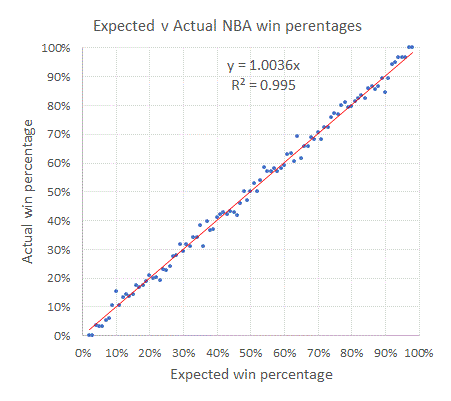
The correlation is very strong and almost 1:1, implying a high degree of price efficiency. Teams predicted to win 20%/40%/60%/80% of the time (by virtue of Pinnacle's odds) actually do win nearly 20%/40%/60%/80% of the time.
Finally, the relative efficiency of bet365 to Pinnacle was tested. For each match a ratio of bet365's price to Pinnacle's margin-removed or fair price was calculated. If Pinnacle's price was accurate relative to bet365, that is to say contained all the relevant market information about the probability of an outcome, then such a price ratio would accurately predict actual returns. For example, where bet365 had a price 5% higher/lower than Pinnacle's margin-removed price, a bettor would expect to see profits of 5%/-5%. The next plot describes what was observed.
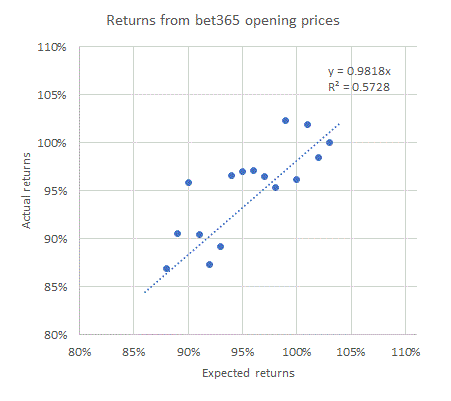
Evidently with the relatively smaller sample size compared to the football data set I analysed in 2017, there is considerably more noise. Nevertheless, the hypothesis that Pinnacle's opening prices contribute almost all the relevant information about outcome probabilities relative to bet365's is broadly confirmed; the slope shows close to a 1:1 correlation.
It is perhaps easier to show the comparison between hypothesis expectation and actual returns by analysing full betting returns. The next chart orders the bet365/fair Pinnacle price ratios in descending order and illustrates how expected and actual betting returns evolve over that sequence. There is a pretty close match.
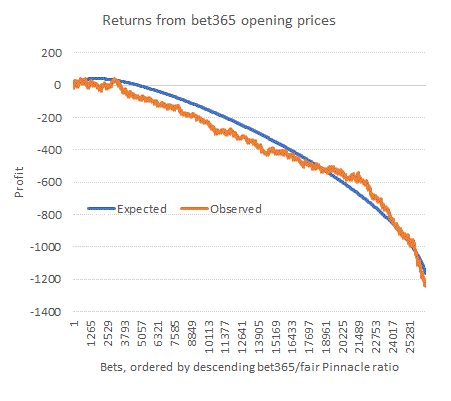
In the next chart I have shown the same sequences of expected and actual betting returns, but instead with the x-axis redrawn using the bet365/fair Pinnacle price ratio. The rapid decline in profits in the middle part of the chart is obviously a consequence of the far greater number of matches with those middle range price ratios, with far fewer of them at the extremes. Effectively, the x-axis is no longer a linear scale, but redrawing in this way is perhaps more useful to demonstrate the close match between expectation and actual outcomes based on results.
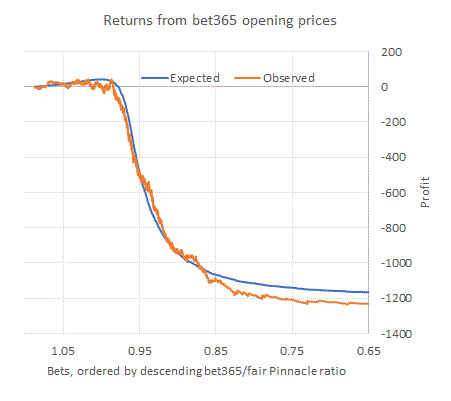
Finally, this price comparison has been repeated but instead by assuming bet365 to be maximally efficiency compared to Pinnacle. This time Pinnacle/fair bet365 price ratios are used, and the charts redrawn.
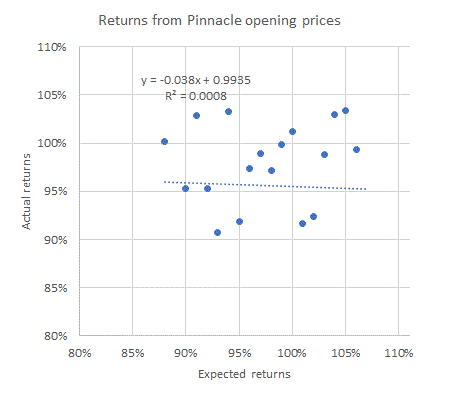
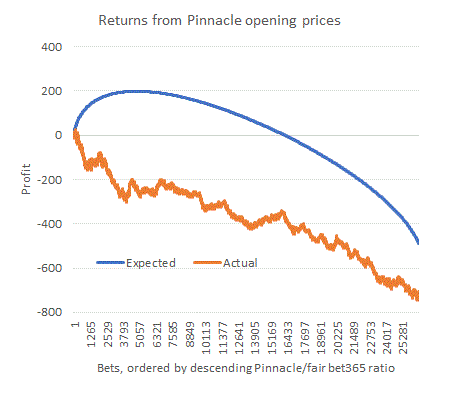
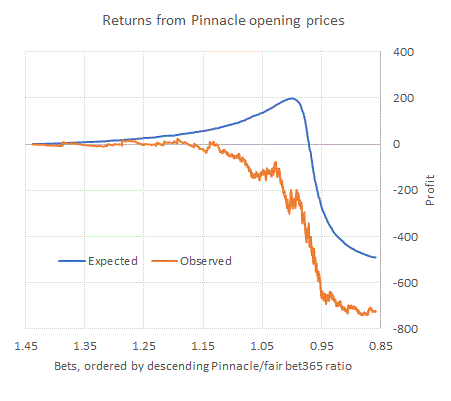
This time there is little correlation between expectation and observation. The implication is that relative to Pinnacle, bet365's opening prices provide little or no meaningful market information about the probabilities of NBA match results. I've already speculated that one of the reasons for this is that Pinnacle typically open their prices later. But given what we already know about their other betting markets, it's probable that the main reason is simply that they have more accurate odds compilers. This is not to argue that Pinnacle's odds compilers are more intelligent or better at forecasting. We also already know that Pinnacle and bet365 utilise different business models. Pinnacle's model which is built on betting volume necessitates them having highly efficient prices. By contrast, bet365's model which is more geared towards customer numbers and market variety means that it is not so important to be perfectly accurate.
|





